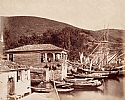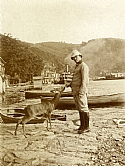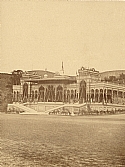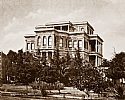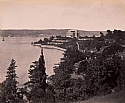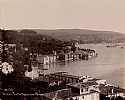Books
FROM KONSTANTİNİYYE TO İSTANBUL
PHOTOGRAPHS OF THE ANATOLIAN SHORE OF THE BOSPHORUS
FROM MID XIXth CENTURY TO THE XXth CENTURY
“Who told you that the heavens are like how your eyes see,
how your mind perceives them?
All you see is nothing but an image, an imitation.”
Ferîdüddin Attâr 1142-1221
[Şahinoğlu 1991, 95-98]
Living in Istanbul is living in an eminently vast world. For nearly two millennia,Istanbul has been a city that draws the entire world’s attention, one that has been longed for. In the past, there have been periods, albeit seldom, during which it was worn down and lost its appeal. Transiently perceived as an ordinary settlement at times, this peerless city was revived as noted by Petrus Gyllius in the XVIth century and reacquired the place it deserves in the history of humanity. In his book published in 1906, Alexander van Millingen wrote,“When anyone taken by the superior qualities of this city decides to leave here to settle somewhere else, horizons of his life will shrink as in giving up the immense landscape from the peak of a mountain and resigning oneself to a life besieged by the walls of a valley.” [CÆTERÆ IGITVR, VT SINT MORTALES, HÆC SANE QVANDIV ERVNT HOMINES, FVTVRA MIHI VIDETVR IMMORTALIS. All other cities are mortal, but Istanbul, I believe, shall live as long as humanity exists. Gyllius 1997, 1]…
As also expressedby many authors in the past, Istanbul has been a very distinctive city with both its geographic features and cultural assets [Istanbul was the city, not any city. Kós 1995, 3] While some cities were buried in the dusty pages of history, this city continued to preserve its existence with considerable resilience. Just like a living organism, cities, too, decide on which features to keep and which ones to let vanish. Unless a supreme will is able to give shape to a city with radical decisions, the city’s will to live shall shape it. This restructuring, this rejuvenation wish, which seems unfavorable in the short-term, is in fact a result of desire to exist, to continue in the future.
In certain periods, during which commerce and the wealth it brings are disregarded, and even scorned, cities become old, pushing the inhabitants of such cities into the grip of pessimism. And all kinds of negative thinking and pessimism lead to introversion and gradual dissipation. Many cities that once enlightened the world, exalted human life with their sheer presence, have oozed away because they could not manage to make the necessary leap and regenerate themselves in their time.
When we take a tour of contemporary Istanbul, read and take interest in her just a little, we can see that she boasts characteristics that can eliminate all our pessimism. Hagop Mintzuri, who came to the city to find work in early XXth century when he was just a young boy, said that his elders had always warned him, saying, “This is Istanbul. There is only one Istanbul in the world, you shall be a decent person here!” [Born in Erzurum’s Armudan village, Hagop Minzuri [1886-1978] published his memories from Istanbul in his book İstanbul Anıları 1897-1940 [Istanbul Memories 1897-1940], where he came to study and work with his father. See Mintzuri 1993, 56].
The Bosphorus has always possessed picturesque views with its bays and capes. While Anadolufeneri is recognized as the starting point in entry to the Bosphorus from the Black Sea, it is hard to claim that Anadolufeneri or the Poyrazköy settlement that follows it still have any organic ties to the city after all these years. The climate also changes from place to place on the Bosphorus. Almost all settlements have been established inside valleys protected against high northern winds or on the shores hidden behind the capes extending to the water.
In the first two volumes of our book, we had discussed the Rumelian side of the Bosphorus from Karaköy to Rumelifeneri. In this volume, we narrate the story of the Anatolian side of the Bosphorus. However, despite a long hunt, we have been unable to locate any photographs from the past of Anadolufeneri and Poyrazköy. In fact, various issues of The Illustrated London News feature engravings of Anadolufeneri, Poyrazköy, and the Filburnu Fortress [London News 1877, 197]. We know that these engravings were created based on previously taken photographs. It seems that either these photographs have not survived to our times or they are tucked away in the unknown dossiers of an archive we could not reach. Accordingly, we have started the story of the Anatolian side with Anadolukavağı.
During our research for the volume on the Anatolian side, we have also found the opportunity to correct some long-standing misunderstandings. For instance, we have found that the field that has come to be known as the Macar Tabya for more than two centuries is actually called Ma-i Cari [Akarsu] Tabyası. We have reached the photographs of a neighborhood [Sütlüce] that was used for a long time as a small settlement, and as a holiday resort particularly in summers, even the name of which has been forgotten today. It was also possible to see some structures that have been forgotten today such as the “Mehtabiye Pavilion” or “Group Kiosk”.
“This city of Istanbul, which is matchless and precious/A stone of it is worth the entire Persian land,”said Nedim, and despite the centuries that have passed ever since, Istanbul has lost nothing of its richness. Although much has changed, Istanbul is now greener than before; while some of the naked hills of the past are now covered with buildings, many areas are shrouded by trees.
Just like people, cultures also complete their lives and vanish into history, but it is possible to take a confident look to the future by benefitting from their accumulation and creating a new culture. This city is ours, hence it is our duty to carry it into the future. While some of us treat her with disrespect, I still believe that the majority appreciates her. The future will surely be hers.
The first two volumes of this book took five years to write. It drew significant attention when it was published in 2006, and my friends encouraged me to continue. And the Anatolian side, which I started writing in 2007, has taken nearly four years to complete. Dear İnan Kıraç has always been the greatest supporter of this work. I owe him a special debt of gratitude. I also would like to offer my endless thanks to Ahmet Abut, who gathered a significant portion of the photographs you are about to see; Uğur Göktaş, who alerted me in every auction regarding photographs about İstanbul and strived for us to obtain many amateur photographs; Uğur Yeğin, who conveyed almost every document about İstanbul he could get his hands on; Serra and Ömer Türel, Engin Özendes, Bahattin Öztuncay, Halil Onur, Lokman Şahin, Burak Çetintaş and Uğur Yeğin, who have allowed us to use some rare shots; Sertaç Karacadağ, who examined and enhanced the photographs one by one; Lokman Şahin and colleagues, who made every effort for the printing of the book in a great spirit of friendship; Savaş Çekiç for his meticulous work and design before going to print; İbrahim Baştuğ for the revisions and readings; my dear friends M. Özalp Birol, M. Baha Tanman and Zeynep Ögel, who never spared their assistance and support; my dear student Belma Barış Kurtel, who provided her full support in all stages of this work, and my beloved wife Renan and daughters Esra and Azra, who have provided me with the required environment for this long-winded work and never let me worry about time with their never-ending tolerance, and to my grandson Sinan Cemil, who I wish will realize similar works in the future.
“Maybe those tunes are still played,
On a sea that ships never pass”
Yahya Kemal Beyatlı


